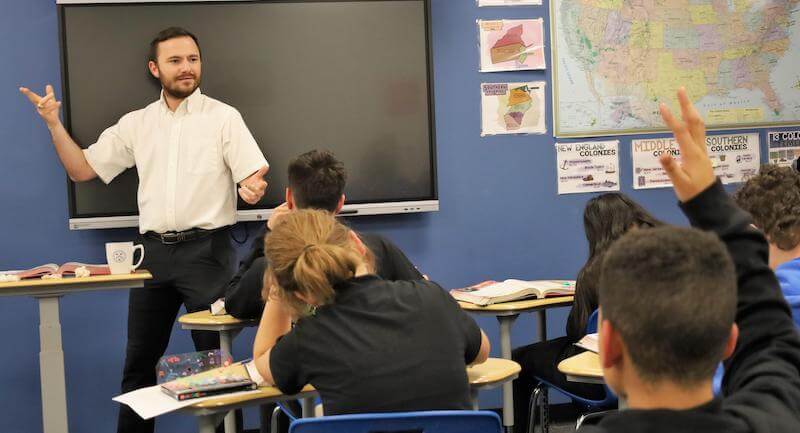Charter schools, of course, are very popular alternatives for parents across the country. Once thought of as a sure thing, however, parents now struggle to get their children enrolled due to surging popularity. It’s easy to see why they're so popular—they do great things for children and offer parents peace of mind. After our team returned from the National Charter Schools Conference in Austin, TX, we thought we would dedicate this week’s post to the emergence, excitement, and future surrounding charter schools.
What are Charter Schools?
First, we’ll provide background about charter schools and why they're successful for anyone who may not know much about them. Charter schools are institutions that are separate from the other public schools in a city or town and run by independent leaders—not state officials. This gives them much more flexibility in what they teach, how they teach it, and even tools they use. In exchange for this greater freedom, charter schools must hold a higher academic standard. Each school is created under a “charter,” which serves as a contract that outlines the school’s mission, the students they are serving, performance goals, and their assessment methods. Every charter school, appropriately, needs on of these.
We mentioned that charter schools are different from conventional public schools and here are some ways they differ. Charter schools are commonly referred to as public schools of choice, which basically means a parent could choose for kids to attend them rather than automatically sending them to a designated public school. Since charter schools are responsible for the academic performance they detail within their charter, they are not able to accept every student who applies because they could be forced to close if they do not totally meet their performance expectations. Aside from that, each charter school is also unique from other charter schools whether that means in design or results. Some instructors focus on principles while others rely on practice to meet performance expectations and both ways are equally effective.
Some charter school management teams manage just one school while others could manage 50 or 100 in all different areas. The various members of these teams also have different departments, including content development, curriculum, fundraising, diversity, IT, performance management, and data analytics. There is often a board for authorizing the schools to operate, kind of like the state Board of Education. Also, lots of different people can create charter schools, including parents, community leaders, business professionals, teachers, and municipal figures. They just have to apply for their charters, lay out their plan, stick to it, and show they’re able to provide a worthwhile opportunity for each of their students to excel.
The Next Generation of Charter School Impact
Since charter schools are free to conduct learning in the best ways they see fit, they pretty much control the effectiveness of their programs and the rate at which these children learn. As we continue to live in a time in which innovation is critical in education, these school leaders are among those who are making a bigger push to bring new methods of teaching into the classroom. With so many trends perforating 21st century education, many administrators are now finding that a commitment to personalized and student-centered learning is the best way to go. And, not only is this approach unlocking beneficial opportunities for charter school students, these schools are becoming some of the top performing in the country.
Dating back to when the charter school really started becoming more prevalent, educational leaders saw a huge opportunity. Since charter school leaders could use whatever methods they’d like in their classrooms, state and district education leaders were keeping a close eye on what worked and relaying that information back to public school leaders in hopes of implementing those same strategies in their schools. While these leaders probably don’t take this into account when planning their curricula, they'll still have that freedom to change their curricula as often as they see fit. And, since innovations in education will refresh all the time, some would argue that your most effective charter leaders are those who can keep up as best as possible. These strategies even include lengthening the school day or school year to measure the effects on student development and achievement.
Today, many top charter school programs rely on integrating technology to drive success. Technology, of course, helps create active learning opportunities for students and expands the possibilities for what they can achieve. Combining EdTech and inquiry-based education, teachers can have success teaching STEM skills and, of course, maintaining performance requirements. Starting their classes by posing a compelling problem to students is a common teaching tactic in these classrooms. This allows students to conduct an investigation, collaborate, find out what works and what doesn’t, and, ultimately, craft a solution. This easy approach works in STEM classes and non-STEM classes and, with the freedom of charter school curricula, educators can use it to really do a lot when it comes to preparing their students for the real world.

Getting Education Leaders and Charter Teachers on the Same Page
Charter schools don't get funding from the same source as the rest of the public schools. Of course, public schools are funded by the state but charter schools are not funded by that same source, which means they don't take money away from traditional public schools. What they offer, however, are alternative options for families who cannot live in certain areas where certain schools are. Charter school leaders live by the tenet that every child deserves the chance at a quality education and the schools they open provide kids with all opportunities they deserve. Rather than holding the notion that charter schools decrease gifted students in public schools, these two school models are partners.
Rather than seeing charter schools as competitions, public school people can consider them a resource to curb overcrowding. We know there's commonly overcrowding in our public schools and, if parents have an option to send their children to charter schools, this helps create smaller class sizes and more attention for children in both schools. It even allows for more individualized instruction for all children—though charter school kids may benefit more in this department. Some students can simply outperform the school system that’s closest to home and shouldn’t be held back by inadequate challenges. This is when sending them to a charter school becomes a legitimate option.
Having an alternative education institution for their children to attend is invaluable for some families. It is in these schools that a child’s love for learning really starts to flourish since they tend to be in an environment they are more comfortable in. They start expressing themselves more and rise up to the greater challenges they will have. As families everywhere struggle to buy their way into high-class neighborhoods with the top schools, charter schools provide an alternative. We must also remember that charter schools don't receive tons of funding, especially when compared to traditional public schools. Still, though, they are available for those who wish to apply and give their children the chance at a more challenging experience and a shot at a better future.
Producing a Bigger Bang with Fewer Bucks
Evidence from a recent study by the University of Arkansas has suggested that students enrolled in charter schools in major cities can enjoy some pretty nice benefits. Or, maybe more appropriately, their parents are enjoying them. One central finding from their study is that these schools are 35 percent more cost-effective than traditional public schools. Another is how they produce a 53 percent higher return-on-investment than residentially assigned schools. More importantly, the schools from that study held a noticeable productivity advantage over traditional schools in the same areas. Despite receiving less resources per student in many cases, these schools often wind up outperforming traditional schools in achievement.
Charter schools also provide bigger returns-on-investment for taxpayers in major cities. Consistently, they provide a significantly higher ROI than district schools do. The numbers from Washington DC indicate that for every $1,000 spent on education in the city’s traditional schools, there is about a $4,500 increase in the students’ lifetime earnings. At the same time, the same $1,000 investment in charter schools generates an estimated $8,340 increase for students’ lifetime earnings. That is almost double. These educators do more with the same funding (or less) than traditional public school teachers and that's just one example. It’s also no surprise that this disparity is noticed by adults around this country. More likely than not, it's contributed to the rising popularity in charter school attendance.
Frankly, these results should not be too surprising to many people. Being able to create their own curricula and steering away from some state-mandated requirements has allowed charter school learning to flourish. Charter schools have the incentive to spend money wisely—not just to spend money—since their ability to stay open is directly related to student achievement. Public schools don't have to attract students because they go to a school near their home. So, they can spend more money on maintaining buildings and on their administrators. Charter schools need to spend money on their students, however, if they want to keep their doors open. So, charter leaders have learned how to maximize these dollars based on this current state of education. They also know how to create innovative opportunities and are succeeding with keeping their schools open by spending money smartly.

Anticipated Enrollment May Only Grow
By now, you can probably guess why charter schools, at least to some parents and education leaders, are legitimate options. This popularity is so elevated, in fact, that some expect growth of close to 25 percent in charter school attendance. To satisfy demand, there is scrambling to open additional charter schools to, of course, keep class sizes small enough everywhere. With the addition of more charter schools comes more parents trying to get their children enrolled. And, since charter schools will technically span different grade levels (K-3 or K-8, for example), they'd only accept around 180 kids if there were one class in every grade (yes, there are usually more). This charter school growth also affects existing charter schools, too as they strive to remain innovative.
For this reason, it’s not uncommon for charter schools in areas where they're popular to make adjustments. The adjustments include adding additional teachers to allow for more classes while keeping the class sizes reasonable. It even includes adding an extra grade or two to an existing charter school so children can stay there longer. Because there is a lot of flexibility in charter schools, these options are possible despite being somewhat unorthodox and tricky. Their growth is also due to the success charter school students go on to have. We touched on the monetary benefits students receive from a charter school education but they also gain more than that. Thanks to the smaller class sizes, students can effectively learn all the most important soft skills, plus STEAM skills. These include collaboration, problem solving, communication, interpersonal, and various listening skills.
As long as people want to open them, charter schools could continue popping up around our country. The more options parents have for alternative school choices, of course, leads to better opportunities for these children. While there are various benefits with attending a charter school, some of those most relevant are the smaller class sizes. There's also the importance to charter school leaders that their students succeed and the fact that they control their curricula. The last involves providing kids this future-ready education and parents who think charter schools might be worthwhile should remember this. Real-world learning is as important now as ever and these schools unlock new avenues—they just need to keep performing.
For the latest EdTech, STEM, and 21st century education news, follow us on Twitter and Instagram. Like us on Facebook, too, or sign up for our newsletter for our latest product announcements and offerings. If you have an idea for an Eduporium Weekly theme, send us a message on social media or comment below.



